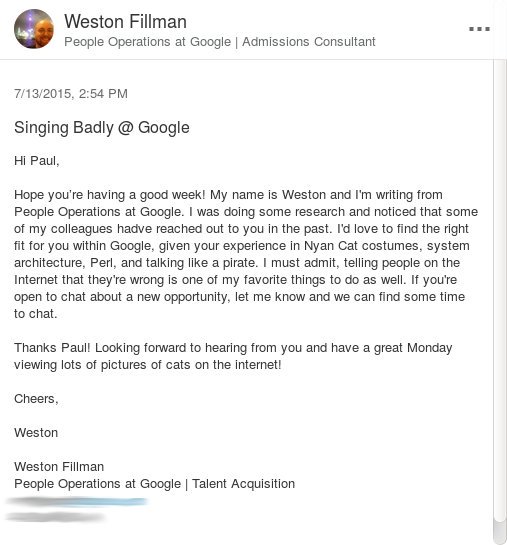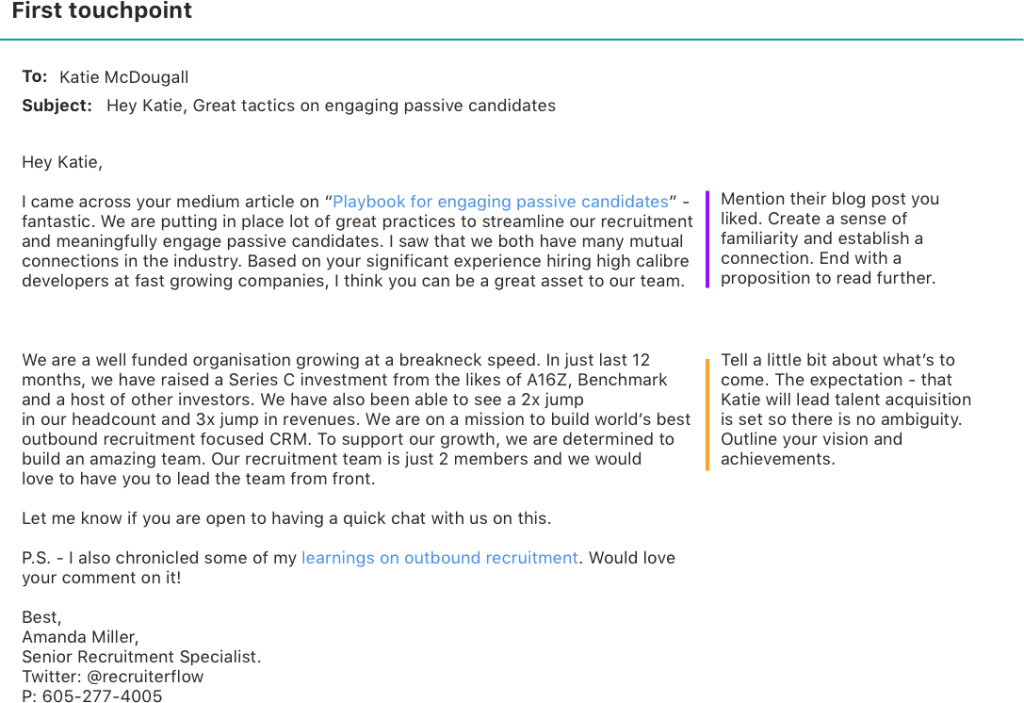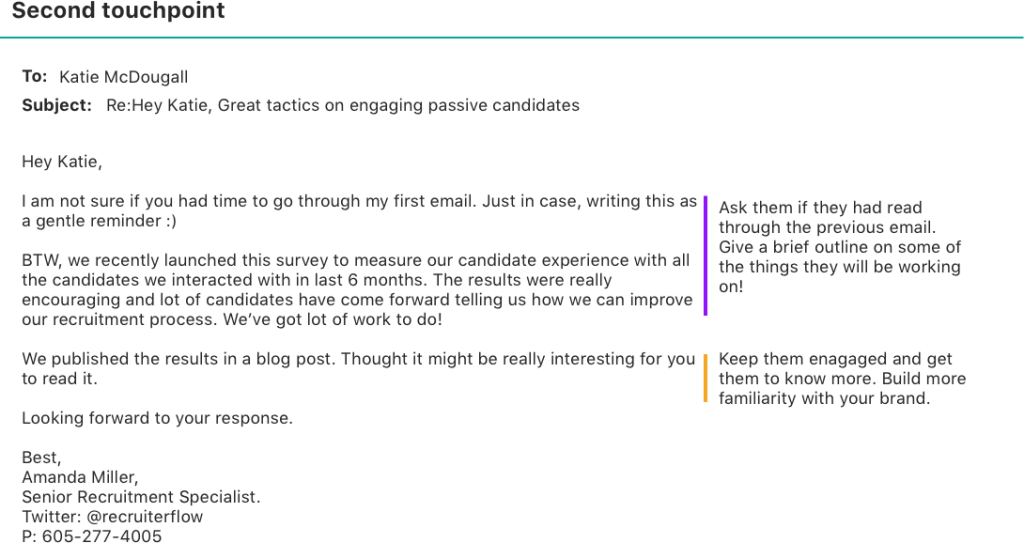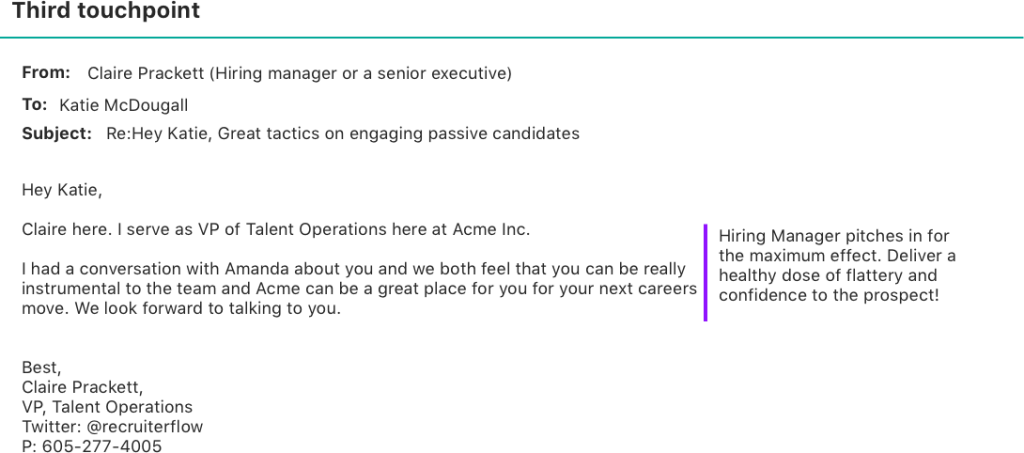Recruitment drip marketing isn’t just the latest buzz term, but a lot of savvy sourcers and recruiters have woken up to its potential. They’re taking a page from the sales reps playbook and using it with some astounding results.
What Drip Marketing Is
A drip campaign is a series of touch points (usually email) delivered automatically to a highly targeted prospect at predefined intervals. It is the weapon of choice in the war for talent.
As recruiters we’ve been using blast email campaigns way too long now. Why should your cold-blast email be a worthy of a response? Such email blasts are not only useless, they also punish your employer brand. Candidate expectations have changed, and our methods to attract them need to change with the times.
Imagine how much better would it be if you could send super-personalized emails to your star prospects right in their primary inbox. Bid adieu to this archaic, age-old process of email blasts and take a more human approach to it. You don’t need to “cast a wider net” and get more and more applicants. What you need is a process that achieves human touch at scale.
When you are reaching out to more than 10 people in a day, balance scale with personalization. Super personalize the first email outreach and then let machine take over rest of the touch points. (Hubspot, whose Becky McCullough is speaking at ERE, was able to get double digit-increases in email outreach through personalized messaging.)
Unlike the other kinds of email campaigns, the only metric of success in a drip campaign is that of replies. Getting a reply means you need to be compelling enough for the prospect to take the effort out to type out a response and hit the send button.
How to Write a Compelling First Email Touchpoint That Prospects Might Reply to
Your communication needs to be aligned with your employer brand, but here’s a no-nonsense way to go about it. There are three parts to crafting your first touchpoint email.
Subject
This is all that the recipient will see before they open the mail and make a split-second decision whether to open it or not. You get only a few words to make an impression. The Gmail iOS app shows only the first 36 characters of subject. Make them count! A great subject line is half the work. Most people I have interacted with write subject lines as an afterthought — there couldn’t be a bigger mistake. You don’t want to write an epic like Lord of the Rings and name it “A tale of hobbits, men and elves.”
In my personal experience, mentioning the recipient’s name in the subject line, mentioning a recent blog they wrote, or an award they won, delivers really high open rates. Generic subject lines like “We’ve got an opportunity” or “Openings at Acme Inc” have abysmally low open rates.
The Connection
The second part of an email is establishing a connection. This is the first thing the recipient will read after they have read the subject line. Keep them engaged. If you had mentioned their blog post in the subject, continue with a comment on that or just compliment them on their post.
This is the point where a recipient will decide whether they want to reply to the email or not. Humans tend to remember the beginning and end of the emails much better than the parts in the middle. How you open a conversation plays a big role in your conversion rates. In an experiment, a group was given 20 words to read and had to recall them afterwards. The experiment concluded that people could recall words in the beginning and end really well but not so much for the words in the middle.
Ask them something
Now that you have established a connection, you ask them something. Be upfront and clear in your message. If you already have an open position for the candidate, just tell them. Be precise about the position and what would it entail. Ask for their time over the next 2-3 days (create a sense of urgency) and close.
How to Personalize the First Email Touchpoint
I remember when an email could mail merge the recipient’s name and organization. It used to be called personalized email (this just made me realize how old I am!). However, now that this kind of personalization is ubiquitous, people feel they are spammy and they expect more. So what are the best way to personalize an email?
Find something in common
Familiarity breeds trust. Our brains are hardwired to treat familiarity with a favorable disposition. For example, if you see a person is a football fan, mentioning your favorite team or player can go a long way. To find common interests, look at your prospect’s interests, hobbies, alma mater, of even the kind of memes they love.
Another way is to find a mutual connection. This has worked really well for me. Check out this brilliant message sent to a prospect by a Google recruiter. Your prospect is leaving their footprints everywhere on social media. All you gotta do is find it and use it!

Compliment them sincerely
Has your prospect recently won an award, got a promotion, or their company has achieved a major milestone? Congratulate them. Flattery preempts our brains to look at the message more favorably. Compliments warm up a cold outreach! Don’t be superficial in your praise. Be earnest and genuinely interested in their lives.
Talk about their work
It is quite possible that you found someone through Github, Medium, or even just a tweet. Mention this. Say how you found it interesting and comment on it. If possible, comment in a way that elicits a response. Raising a question is a great way to do that.
Here’s what a great first personalized email might look like. It’s better to keep experimenting on it and find the way that works best for you.

Strategy for Subsequent Touch Points
If the first email did not get you a great response despite of your carefully crafted super personalized email, don’t lose heart. It’s always the second and the third touchpoint that generates best conversions. These emails make sure that you stayed on top of recipient’s mind. Two things to note
- It is better to send the subsequent touch points in the same thread as the first one. It helps you maintain the context.
- In the interest of time and scale, it is not necessary to super personalize subsequent touch points. You can send these emails completely automated.
For the second touchpoint, pick up where you left. Politely say you don’t know if “you missed the earlier email.” Reaffirm your value proposition with a blog post or even a Dribbble page that was a result of some exceptional work done by your team. See example.

In the third touchpoint, if possible involve the hiring manager or a senior member of the team. If the prospect hasn’t replied to both the emails, but opened and read both of them, s/he just needs a little bit of a push to get over the edge. Sending an email from the hiring manager is a great way to do this. The hiring manager can explain a bit more about the role and challenges to get them excited about the role!
The hiring manager and the prospect are people in the same trade and can form an instant connection. The email instills confidence in the prospect’s mind that you really want to talk to them. It’s hard to say no to that.

The final outreach is where you keep the door open for a future conversation while still trying to get a response. Keep it professional but also make sure that candidate feels like you are really interested in them and want to talk to them.
Dos and Don’ts
Drip marketing is fairly easy to understand and execute. However, for the uninitiated to get started quickly, I’ve put together a list of basic dos and don’ts. It’s primarily distilled from my own experience and experience of others that I have worked with.
Dos:
- Keep the subject line short, especially since most email are now read on mobile devices and only 36 characters are visible on gmail iOS app
- Always think from the recipient’s perspective. Much easier said than done!
- Use the prospect’s name at least twice. Preferably, once in the subject line.
- Be brief. Everybody hates long emails. My advice: Keep it shorter than 100 words.
- Be sincere and sound like a human who has a genuine interest in them
- Double check on the content and see if the mail merge has properly filled out the data
- Space out your touch points based on how warm or cold the prospect is. A general best practice is to wait for 3-4 days before sending a follow up email.
- Put in a strong call to action.
- Generally most replies come with the second and third mail. Keep the email chain short. We have seen great results with four or five emails.
- Determine a strategy on how you will balance scale with personalization.
- Write all the email is one session. Best way to make sure that they have a tone of continuity.
Don’ts:
- Don’t think that mentioning a name and organization means you have personalized outreach
- Don’t overdo it. Overdoing can be really hurtful to your brand. Your campaign should not involve more than 10 touch points for sure.
- Don’t neglect to give enough information for recipients to decide.
- Don’t go solo. Involve your team in this. Ask hiring managers.
- In the zeal to personalize, don’t use the prospect’s name more than four times. That just makes it awkward.
- Don’t think you deserve a response just because you spent so much time finding out about them. It’s a tough trade!
- Don’t go overboard with praising the candidate and their fit in your team. Remember, you might end up saying no to this candidate. Don’t make it harder than it has to be.
image from bigstock